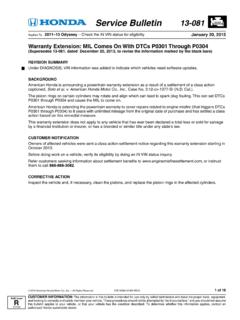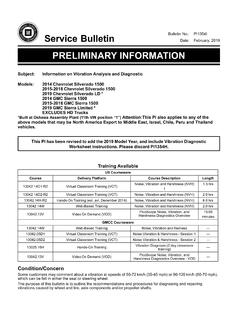Transcription of Assessment Service Bulletin Number 6
1 Assessment Service Bulletin Number 6 Use of the Woodcock-Johnson IV for the Assessment of DyslexiaCarla M. Proctor, PhD, LDTN ancy Mather, PhDTammy L. Stephens, PhDCopyright 2015 by The Riverside Publishing Company. No part of this work may be reproduced or transmitted in any form or by any means, electronic or mechanical, including photocopying and recording, or by any information storage or retrieval system, without the prior written permission of Riverside unless such copying is expressly permitted by federal copyright law. Requests for permission to make copies of any part of the work should be addressed to Houghton Mifflin Harcourt Publishing Company, 9400 Southpark Center Loop, Orlando, FL 32819-8647; in the United States of is a registered trademark of Houghton Mifflin Harcourt Publishing IV and the Woodcock-Johnson IV logo are trademarks of Houghton Mifflin Harcourt Publishing Citation To cite this document, use: Proctor, C.
2 M., Mather, N., & Stephens, T. L. (2015). Use of the Woodcock-Johnson IV for the Assessment of Dyslexia (Woodcock-Johnson IV Assessment Service Bulletin No. 6). Rolling Meadows, IL: technical information, please visit or call Riverside Customer Service at Service Bulletin Number 6 1 Use of the Woodcock-Johnson IV for the Assessment of DyslexiaThe purposes of this Assessment Service Bulletin are to (a) describe the useful features of the Woodcock-Johnson IV (WJ IV ; Schrank, McGrew, & Mather, 2014a) that may be included in an evaluation for dyslexia, (b) present the WJ IV Dyslexia Profile of Scores, and (c) describe the WJ IV Dyslexia Summary Report.
3 The WJ IV includes three co-normed batteries that can be used together or independently: the Woodcock-Johnson IV Tests of Cognitive Abilities (WJ IV COG; Schrank, McGrew, & Mather, 2014b), the Woodcock-Johnson IV Tests of Oral Language (WJ IV OL; Schrank, Mather, & McGrew, 2014b), and the Woodcock-Johnson IV Tests of Achievement (WJ IV ACH; Schrank, Mather, & McGrew, 2014a). The authors begin with a brief discussion of the characteristics and definitions of dyslexia, and then describe how the various clusters and tests of the WJ IV may be used in the WJ IV Dyslexia Profile of Scores to assist in the organization of Assessment data and in the determination of dyslexia.
4 The WJ IV Dyslexia Summary Report provides an overview of the characteristics of dyslexia, the possible contributing factors, and the strengths that may exist. The WJ IV Dyslexia Summary Report and WJ IV Dyslexia Profile of Scores were developed from concepts presented in Essentials of Dyslexia: Assessment and Intervention (Mather & Wendling, 2012) and The Dyslexia Handbook: Procedures Concerning Dyslexia and Related Disorders (Texas Education Agency, 2014).What Is Dyslexia?The word dyslexia comes from the Greek words dys, meaning impaired, and lexia, meaning word.
5 Dyslexia is a cognitive disorder of neurological origin that is manifested in deficiencies in decoding, word-level reading skills, and encoding, or the ability to spell words in print (Mather & Wendling, 2012; Vellutino & Fletcher, 2007). The difficulty pronouncing printed words in turn affects the speed or rate of reading. Nearly all states identify dyslexia as a type of learning disability that warrants services through special education. A few states including Texas, however, identify and address dyslexia through both general and special education (Texas Education Agency, 2014).
6 Parents and educators may be puzzled over the difference between a specific learning disability and dyslexia. Actually, dyslexia is a one of the specific types of disorders included in the category of specific learning disability (Mather & Wendling, 2012; Shastry, 2007). Dyslexia has been recognized by the American Psychiatric Association (APA, 2013) as an alternative term for the diagnosis of specific learning disorder with impairment in reading ( ) in the Diagnostic and Statistical Manual of Mental Disorders (5th ed.; DSM-5; American Psychiatric Association [APA], 2013).
7 In some states, it is referred to as a specific reading disability. Dyslexia refers to a pattern of learning difficulties characterized by problems with accurate or fluent word recognition, poor decoding, and poor spelling abilities. The APA also notes, If dyslexia is used to specify this particular pattern of difficulties, it is important also to specify any additional 2 Assessment Service Bulletin Number 6difficulties that are present, such as difficulties with reading comprehension or math reasoning (APA, 2013, p. 67).Definitions of dyslexia guide the process of Assessment for identification.
8 Most definitions identify it as a neurobiological disorder, which means that differences in the brain affect the development of reading and spelling skills. The most commonly used definition for dyslexia in the United States, which was developed by the International Dyslexia Association (IDA, 2015), states:Dyslexia is a specific learning disability that is neurological in origin. It is characterized by difficulties with accurate and/or fluent word recognition and by poor spelling and decoding abilities. These difficulties typically result from a deficit in the phonological component of language that is often unexpected in relation to other cognitive abilities and the provision of effective classroom instruction.
9 Secondary consequences may include problems in reading comprehension and reduced reading experience that can impede growth of vocabulary and background knowledge. (para. 1)This definition, adopted by the IDA Board in November of 2002, describes dyslexia as a language-based learning disorder that originates from a basic problem in phonological processing and affects reading and writing. Other international definitions of dyslexia expand upon the cognitive factors that may contribute to dyslexia. For example, the British Dyslexia Association uses this definition:Dyslexia is a specific learning difficulty which mainly affects the development of literacy and language related skills.
10 It is likely to be present at birth and to be lifelong in its effects. It is characterized by difficulties with phonological processing, rapid naming, working memory, processing speed, and the automatic development of skills that may not match up to an individual s other cognitive abilities. (British Dyslexia Association Management Board, 2007)An evaluation for dyslexia includes Assessment in the primary reading and spelling achievement areas in which difficulties are characteristic of dyslexia: letter identification, letter/sound associations, sight word identification, phonics (decoding), reading fluency and rate, and spelling.







